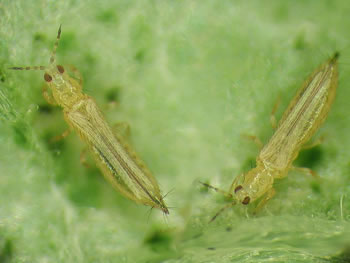Western flower thrips (Frankliniella occidentalis)
 Western flower thrips Source: Moritz, G. (2006): Thripse. Westarp Wissenschaften, Hohenwarsleben, 384 pp. |
Contact: Dorith Rotenberg
Researchers involved: 200
Size (or size of nearest relative): 380 MBp
Keywords (and why important): (agriculture, systematics).
Frankliniella occidentalis, the western flower thrips, is a representative of the order Thysanoptera. This insect order is composed exclusively of tiny insects commonly called thrips, and includes more than 7,000 species.
Thrips are considered to be members of the hemipteroid assemblage, which includes the orders Hemiptera, Pscocoptera, and Phthiraptera.
Thysanopterans display an extraordinary amount of diversity with respect to food preference and behaviors. They share, however, some common, but unique, characteristics such as asymmetrical mouthparts composed of a fully developed left mandible and a resorbed right mandible during embryonic development and postembryonic ‘remetaboly’ development, a process that is intermediate between holometaboly and hemimetaboly development.
Frankliniella occidentalis is the most economically-important agronomic pest worldwide within Thysanoptera because it is a direct pest and an efficient vector of plant pathogenic viruses. F. occidentalis is polyphagous, feeding on a wide array of plant species and plant organs.
The insect is haplo-diploid, i.e., haploid males arise from unfertilized eggs, while diploid females develop from fertilized eggs. The short reproductive cycle (~12 days, egg to adult) and high fecundity (~75 eggs per female) of this species contributes to its success as an invasive species.
This species transmits at least five described Tospovirus species (negative strand RNA viruses) to hundreds of food, fiber, and ornamental crops. F. occidentalis efficiently transmits the type member, Tomato spotted wilt virus (TSWV), in a persistent propagative fashion and the virus is passed transstadially from the young larval to pupul to adult developmental stages.
Despite their diversity, biological uniqueness, and economic importance as world-wide crop pests, there are currently no genomics resources available for insects classified in Thysanoptera. Genomics resources for this thrips species would provide tools to identify vector proteins involved in virus acquisition, replication and movement inside thrips tissues, and transmission to plants.
Genomic Resources
For the most current version of the assembly, please use 'NCBI BioProject' (find link below). If the assembly is unavailable in the BioProject page (it is still being worked on), you can look under the 'BCM-HGSC data' (find link below) for intermediate versions of the assembly.
Web Apollo: A web-based sequence annotation editor for community annotation
For information about Web Apollo, please contact Monica Poelchau.
-
Web Apollo annotation tool (requires log in)
-
Web Apollo Jbrowse viewing of the automated annotation tracks (no log in required)